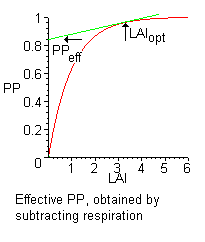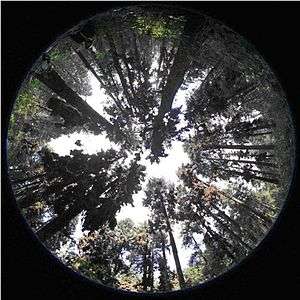Leaf area index
Leaf area index (LAI) is a dimensionless quantity that characterizes plant canopies. It is defined as the one-sided green leaf area per unit ground surface area (LAI = leaf area / ground area, m2 / m2) in broadleaf canopies.[1] In conifers, three definitions for LAI have been used:
- Half of the total needle surface area per unit ground surface area [2]
- Projected (or one-sided, in accordance the definition for broadleaf canopies) needle area per unit ground area
- Total needle surface area per unit ground area [3]
The definition “half the total leaf area” pertains to biological processes, such as gas exchange, whereas the definition “projected leaf area” was disregarded because the projection of a given area in one direction may differ in another direction when leaves are not flat, thick, or 3D-shaped. Moreover, “ground surface area” is specifically defined as “horizontal ground surface area” to clarify LAI on a sloping surface. The definition “half the total leaf area per unit horizontal ground surface area” is suitable for all kinds of leaves and flat or sloping surfaces.[4]
Interpretation and application

LAI is a measure for the total area of leaves per unit ground area and directly related to the amount of light that can be intercepted by plants. It is an important variable used to predict photosynthetic primary production, evapotranspiration and as a reference tool for crop growth. As such, LAI plays an essential role in theoretical production ecology. An inverse exponential relation between LAI and light interception, which is linearly proportional to the primary production rate, has been established:[5][6]
where Pmax designates the maximum primary production and designates a crop-specific growth coefficient. This inverse exponential function is called the primary production function.
LAI ranges from 0 (bare ground) to over 10 (dense conifer forests).[7]
Determining LAI
LAI can be determined directly by taking a statistically significant sample of foliage from a plant canopy, measuring the leaf area per sample plot and dividing it by the plot land surface area. Indirect methods measure canopy geometry or light extinction and relate it to LAI.[8]
Direct methods
Direct methods can be easily applied on deciduous species by collecting leaves during leaf fall in traps of certain area distributed below the canopy. The area of the collected leaves can be measured using a leaf area meter or an image scanner and image analysis software (ImageJ) and mobile applications (Leafscan, Petiole, Easy Leaf Area). The measured leaf area can then be divided by the area of the traps to obtain LAI. Alternatively, leaf area can be measured on a sub-sample of the collected leaves and linked to the leaf dry mass (e.g. via Specific Leaf Area, SLA cm2/g). That way it is not necessary to measure the area of all leaves one by one, but weigh the collected leaves after drying (at 60–80 °C for 48 h). Leaf dry mass multiplied by the specific leaf area is converted into leaf area.
Direct methods in evergreen species are necessarily destructive. However, they are widely used in crops and pastures by harvesting the vegetation and measuring leaf area within a certain ground surface area. It is very difficult (and also unethical) to apply such destructive techniques in natural ecosystems, particularly in forests of evergreen tree species. Foresters have developed techniques that determine leaf area in evergreen forests through allometric relationships.
Due to the difficulties and the limitations of the direct methods for estimating LAI, they are mostly used as reference for indirect methods that are easier and faster to apply.
Indirect methods

Indirect methods of estimating LAI in situ can be divided in two categories:
- indirect contact LAI measurements such as plumb lines and inclined point quadrats
- indirect non-contact measurements
Due to the subjectivity and labor involved with the first method, indirect non-contact measurements are typically preferred. Non-contact LAI tools, such as hemispherical photography, Hemiview Plant Canopy Analyser from Delta-T Devices, the CI-110 Plant Canopy Analyzer from CID Bio-Science, LAI-2200 Plant Canopy Analyzer from LI-COR Biosciences and the LP-80 LAI ceptometer from Decagon Devices, measure LAI in a non-destructive way. Hemispherical photography methods estimate LAI and other canopy structure attributes from analyzing upward-looking fisheye photographs taken beneath the plant canopy. The LAI-2200 calculates LAI and other canopy structure attributes from solar radiation measurements made with a wide-angle optical sensor. Measurements made above and below the canopy are used to determine canopy light interception at five angles, from which LAI is computed using a model of radiative transfer in vegetative canopies. The LP-80 calculates LAI by means of measuring the difference between light levels above the canopy and at ground level, and factoring in the leaf angle distribution, solar zenith angle, and plant extinction coefficient. Such indirect methods, where LAI is calculated based upon observations of other variables (canopy geometry, light interception, leaf length and width,[9] etc.) are generally faster, amenable to automation, and thereby allow for a larger number of spatial samples to be obtained. For reasons of convenience when compared to the direct (destructive) methods, these tools are becoming more and more important.
Disadvantages of methods
The disadvantage of the direct method is that it is destructive, time consuming and expensive, especially if the study area is very large.
The disadvantage of the indirect method is that in some cases it can underestimate the value of LAI in very dense canopies, as it does not account for leaves that lie on each other, and essentially act as one leaf according to the theoretical LAI models.[10] Ignorance of non-randomness within canopies may cause underestimation of LAI up to 25%, introducing path length distribution in the indirect method can improve the measuring accuracy of LAI.[11]
See also
- Canopy (ecology)
- Hemispherical photography
- Normalized Difference Vegetation Index
- Specific leaf area
- Plant growth analysis
References
- Watson, D.J. (1947). "Comparative physiological studies on the growth of field crops: I. Variation in net assimilation rate and leaf area between species and varieties and within and between years". Annals of Botany. 11: 41–76. doi:10.1093/oxfordjournals.aob.a083148.
- Chen, J.M.; Black, T.A. (1992). "Defining leaf area index for non-flat leaves". Agricultural and Forest Meteorology. 57: 1–12. doi:10.1016/0168-1923(91)90074-z.
- GHOLZ, HENRY L.; FITZ, FRANKLIN K.; WARING, R.H. (1976). "Leaf area differences associated with old-growth forest communities in the western Oregon Cascades". Canadian Journal of Forest Research. 6 (1): 49–57. doi:10.1139/x76-007.
- Yan, G.J.; Hu, R.H.; Luo, J.H.; Marie, W.; Jiang, H.L.; Mu, X.H.; Xie, D.H.; Zhang, W.M. (2019). "Review of indirect optical measurements of leaf area index: Recent advances, challenges, and perspectives". Agricultural and Forest Meteorology. 265: 390–411. doi:10.1016/j.agrformet.2018.11.033.
- Firman, D. M., and E. J. Allen. “Relationship between Light Interception, Ground Cover and Leaf Area Index in Potatoes.” The Journal of Agricultural Science 113, no. 3 (December 1989): 355–59. https://doi.org/10.1017/S0021859600070040. https://www.niab.com/uploads/files/Light_interception_ground_cover_LAI_Firman_Allen_1989.pdf
- Asner, Gregory P, Jonathan M O Scurlock, and Jeffrey A Hicke. “Global Synthesis of Leaf Area Index Observations: Implications for Ecological and Remote Sensing Studies.” Global Ecology, 2003, 15. http://www2.geog.ucl.ac.uk/~mdisney/teaching/teachingNEW/GMES/LAI_GLOBAL_RS.pdf
- Iio, Atsuhiro; Hikosaka, Kouki; Anten, Niels P. R.; Nakagawa, Yoshiaki; Ito, Akihiko (2014). "Global dependence of field-observed leaf area index in woody species on climate: a systematic review". Global Ecology and Biogeography. 23 (3): 274–285. doi:10.1111/geb.12133. ISSN 1466-8238.
- Breda, N (2003). "Ground-based measurements of leaf area index: A review of methods, instruments and current controversies". Journal of Experimental Botany. 54 (392): 2403–2417. doi:10.1093/jxb/erg263.
- Blanco, F.F.; Folegatti, M.V. (2003). "A new method for estimating the leaf area index of cucumber and tomato plants". Horticultura Brasileira. 21 (4): 666–669. doi:10.1590/S0102-05362003000400019.
- Wilhelm, W.W.; Ruwe, K.; Schlemmer, M.R. (2000). "Comparisons of three Leaf Area Index Meters in a Corn Canopy". Crop Science. 40 (4): 1179–1183. doi:10.2135/cropsci2000.4041179x.
- Hu, Ronghai; Yan, Guangjian; Mu, Xihan; Luo, Jinghui (2014). "Indirect measurement of leaf area index on the basis of path length distribution". Remote Sensing of Environment. 155: 239–247. doi:10.1016/j.rse.2014.08.032.
Notes
- Non-Existence of an Optimum Leaf Area Index for the Production Rate of White Clover Grown Under Constant Conditions
- Law, B.E., T. Arkebauer, J.L. Campbell, J. Chen, O. Sun, M. Schwartz, C. van Ingen, S. Verma. 2008. Terrestrial Carbon Observations: Protocols for Vegetation Sampling and Data Submission. Report 55, Global Terrestrial Observing System. FAO, Rome. 87 pp.
- LAI Definition of University of Giessen, Germany